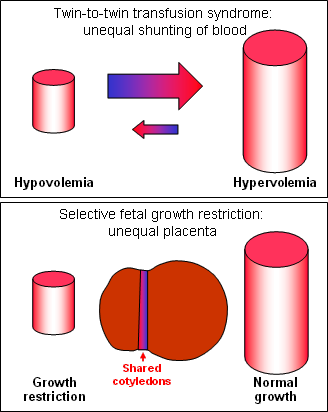Monochorionic twins
Complications
Twin-to-twin transfusion syndrome (TTTS). In about 80% of monochorionic twins there is a balance in the net flow of blood across the placental vascular connections from one to the other fetus. However, in about 20% of cases there is an inbalance in flow from one fetus (donor) to the other (recipient) resulting in TTTS. In half of the cases (10% of the total) severe TTTS develops by 16-24 weeks with polyhydramnios in the sac of the polyuric recipient and oligohydramnios in the sac of the anuric donor. The disease has been divided into four stages (Quintero classification). In stage 1 (polyhydramnios / oligohydramnios) and stage 2 (polydramnios / anhydramnios with no bladder filling in the donor) there is no cardiovascular compromise in the fetuses, unlike stage 3 (absent or reversed end-diastolic flow in the umbilcal arteries of the donor and/or absent or reversed a-wave in the ductus venosus of the recipient) and stage 4 (hydrops in the recipient)
Selective fetal growth restriction (FGR). Another complication which occurs in about 10% of monochorionic twins is poor growth in one of the fetuses (selective FGR) due to unequal sharing of the placenta between the two fetuses. In this case the one fetus is normally grown with normal activity, fetal Doppler indices and amniotic fluid. The FGR twin demonstrates the features of placental insufficiency, including asymmetrical growth with increased head to abdomen circumference ratio, reduced activity and amniotic fluid and Doppler evidence of redistribution in the fetal circulation with increased pulsatility index (PI) in the umbilical artery and ductus venosus and decreased PI in the middle cerebral artery

